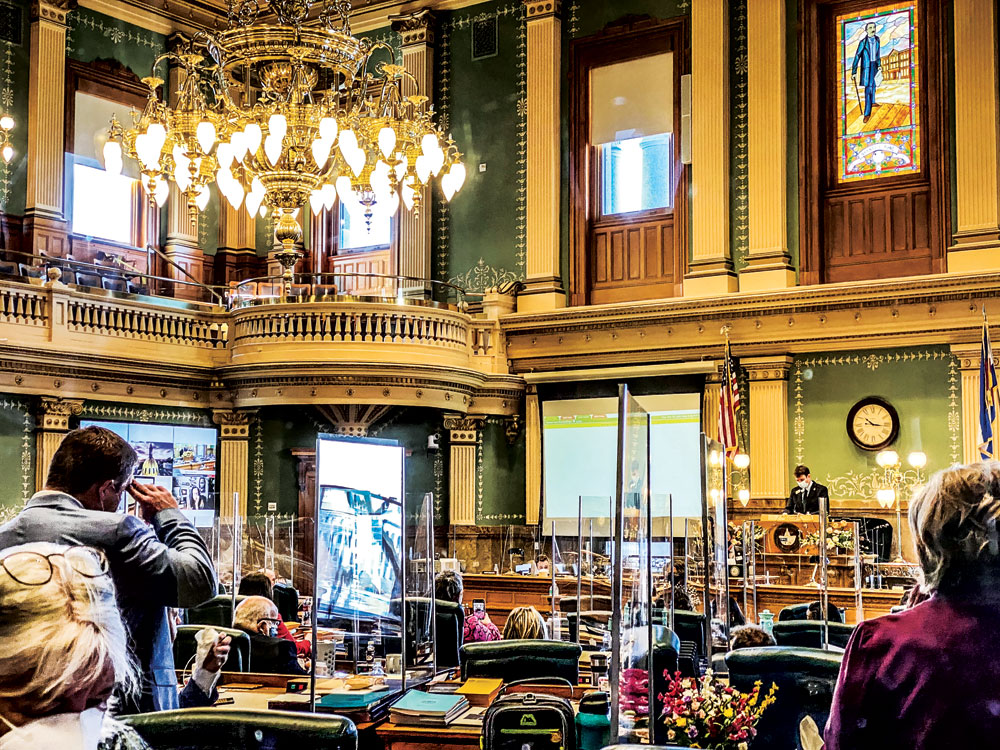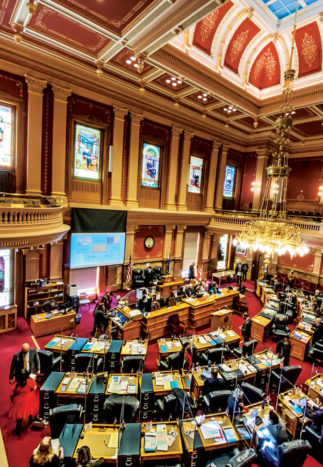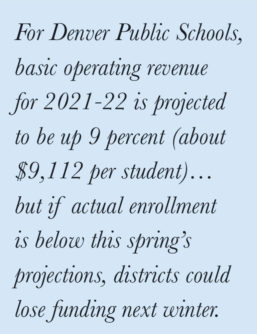
Representatives’ seats were divided by plexiglass when they went back to work in February.
What a difference a year makes. State spending and public school funding, both battered by the pandemic in the current budget year, are set to bounce back significantly in the upcoming fiscal year, which starts July 1.

Fearing reduced revenue during the pandemic, legislators trimmed the 2020-21 budget. But when they convened in January, they learned they had about $3 billion “extra” funds to spend or save in 2020-21. With those funds, they were able to restore cuts in education and other areas.
Next year’s state budget is $4 billion larger than the current budget. And for schools, lawmakers were able to reverse a roughly $500 million cut imposed by legislators in 2020.
Two things helped make it possible for the Colorado General Assembly to engineer a dramatic budget recovery.
First, fearing that the growing pandemic would devastate state revenues, the 2020 legislative session trimmed back plans for the 2020-21 state budget, setting it 4 percent below the $33 billion allocated for 2019-20.
But, second, it turned out later that COVID-19 didn’t shrink revenue in 2019-20. Just before the 2021 session convened in January, lawmakers learned they had about $3 billion in “extra” funds to spend or save in 2021-22.
That allowed them to restore cuts in the state budget—primarily a combined $1 billion reduction in K-12 and higher education funding—plus give state employees a raise and increase payment rates to health care and other agencies that provide services to clients on behalf of state agencies. Next year’s budget is more than $34.5 billion, including state tax revenues, federal funds and cash revenues such as college tuition payments.
This year’s legislature also increased the state reserve to an unprecedented $1.7 billion, more than 13 percent, and set aside about $800 million for state-funded pandemic relief programs and economic stimulus.
Funding boost gives school districts breathing room
School funding consumes one of the biggest shares of the budget—the state contributes about two-thirds of K-12 operating costs, set at $7.8 billion next school year. That’s an average of $8,857 per student statewide, a 9.7 percent increase.
 For Denver Public Schools, basic operating revenue for 2021-22 is projected at $817.8 million, about $9,112 per student, up 9 percent. For Aurora Public Schools the figures are $366.7 million total, about $10,000 per student for an 8 percent increase.
For Denver Public Schools, basic operating revenue for 2021-22 is projected at $817.8 million, about $9,112 per student, up 9 percent. For Aurora Public Schools the figures are $366.7 million total, about $10,000 per student for an 8 percent increase.
There’s an important caveat to remember, however. When the legislature approves school funding every spring, amounts are based on enrollment projections. District-by-district funding gets reset every February after actual enrollment is recorded. Because of the pandemic, statewide enrollment dropped by about 30,000 this school year. Some students moved to online education, many parents apparently held kindergarten students out of school for a year and some students just disappeared.
It’s hard to know how many students will return to district schools in 2021-22. If actual enrollment is below this spring’s projections, districts could lose funding next winter, in the middle of the budget year. Current projections calls for Denver and Aurora enrollment to be flat or slightly down next year.
Low-income and English language learners and other programs get one-time funds
The 2021-22 school funding bill also contains an important but one-time bonus, an additional $77.4 million that will be distributed to districts to support education of low-income and English language learner students. This will provide about $10 million for DPS and $4 million for Aurora.
This at-risk funding is not included in the base of the school finance formula. Many lawmakers and education interest groups have been advocating reform of that formula to direct more funding to at-risk students. The $77.4 million is a compromise allowing discussion of broader reform to be put off until next year.
The school finance bill also restores funding for some specialized programs, such as one that gives school districts grants to increase their counseling staffs.
Additional budget and spending bills related to the pandemic
Work on the budget and school finance was completed in mid-May, but the 2021 session wasn’t expected to adjourn until early June. In a normal year the budget bill plus a few related measures and the school funding bill account for most state spending. This session lawmakers have two additional stacks of spending bills to consider, both sets related to the pandemic.
Pandemic relief package 1
The first is a group of nearly 40 measures to be funded by that $800 million in state revenues set aside for pandemic relief. Those measures were still working their way through the process as May came to a close.
-Most of those bills provide funding for economic development, workforce training, support for clean energy initiatives, funding for water projects, rural development, affordable housing, wildfire mitigation, and suppression and broadband expansion.
Highway funds—The most expensive bill in the group is a $124 million transfer to the state highway fund.
Child care centers & school air purifying—But the package also includes a bill proposing $13 million in grants for child care centers and another measure that includes $10 million for distribution to schools to buy air purifying systems.
Pandemic relief package 2
The second package of spending bills hasn’t been assembled yet, but those measures ultimately will direct spending of $3.8 billion in new federal stimulus and pandemic recovery funds.
Federal officials only issued guidance in mid-May on how that money can be spent, and legislative staff analysts were parsing those rules to figure out what exactly lawmakers can do with the money. Lawmakers were awaiting interpretation so they could decide how quickly they needed to appropriate the funds.
Todd Engdahl owns Capitol Editorial Services, a firm that provides legislative coverage, intelligence, and analysis to private clients. During a long career as an editor and public policy journalist, he served as executive city editor of The Denver Post, founder of DenverPost.com and a founder of Education News Colorado, which later became part of Chalkbeat Colorado.
Front Porch photos by Steve Larson


0 Comments